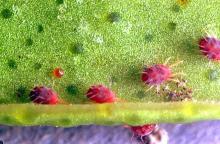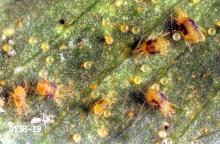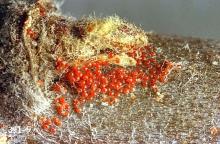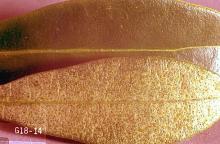Primarily
European red spider mite (Panonychus ulmi)
McDaniel spider mite (Tetranychus mcdanieli)
Twospotted spider mite (Tetranychus urticae)
Yellow spider mite (Eotetranychus carpini borealis)
Pest description and crop damage All adult mites are small, usually only about 0.02 inch in length and typically have eight legs. The various apricot-infesting species vary in appearance as follows:
European red spider mite: Adults are globular, reddish with white spines. Immature mites are similar in appearance, only smaller. Eggs are red and globular.
Twospotted and McDaniel spider mite: Adults are yellowish-brown, about 0.01 to 0.02 inch in length. Twospotted mites have two dark spots on the body, while McDaniel mites have four. Immature mites are similar in appearance, only smaller. Eggs are round and translucent to opaque.
Yellow spider mite: Adult females are pale yellow to white with two or three dark, rectangular markings on each side of the abdomen. Immature mites are similar in appearance to the twospotted spider mite but have more of a yellowish color. Eggs are clear and spherical.
These spider mites damage tissues by puncturing individual plant cells, then sucking the contents out of the cell. The damage appears as small yellow-white spots on the upper leaf surface. In heavy infestations, the spots coalesce and the leaf yellows or bronzes.
For mite identification, see:
Field Characteristics of Fruit-Tree-Attacking Spider Mites in the Pacific Northwest
Biology and life history McDaniel, twospotted, and yellow spider mites overwinter as fertilized females under bark or in soil debris. The European red spider mite overwinters as eggs in crevices of twig bark and young limbs. They move to young foliage when buds break in spring and produce many generations from spring to autumn. Females can lay up to ten eggs per day and more than 200 during their lifetime. Egg-to-adult development can occur in seven to ten days during summer. They thrive under hot, dry conditions. Large colonies of mites produce webbing along leaf midveins. Mite dispersal occurs mainly through wind transport.
Pest monitoring Scout your tree periodically during the summer months for stippled or yellowing leaves, especially in trees with a history of spider mite damage or water-stressed trees. Confirm the presence of mites by using a hand lens to view the undersides of leaves for the mites, their eggs and webbing.
Management-biological control
Spider mite populations are held down by cool, wet conditions early in the season. Considerable natural control is provided by lady beetles (Stethorus spp.) and minute pirate bugs (Orius spp.). Predator mites such as Typhlodromus spp. or Neoseiulus fallacis are also effective at managing populations of spider mites and may be commercially available. Avoid broad-spectrum and pyrethroid sprays during the growing season due to their negative effect on natural enemies.
Management-cultural control
Spider mite infestations are favored by dry, dusty conditions, so avoid creating these problems and stressing the plants. The use of cover crops also reduces dust and mite problems. Broadleaf weeds like mallow, bindweed, white clover, and knotweed enhance mite numbers. Suppression of these weeds with cultivation or grasses may reduce mite numbers. Mites may be washed from the tree with a strong stream of water. Water trees properly, as drought-stressed trees are more susceptible. Avoid excessive nitrogen applications, as this encourages mites.
Management-chemical control
When applied during the dormant or delayed dormant season, horticultural oils can greatly reduce European red spider mite populations later in the season.
Management-chemical control: HOME USE
Dormant-season spray
- superior-type oil (European red spider mite only)-Some formulations are OMRI-listed for organic use.
Growing-season spray
- azadirachtin (neem oil)-Some formulations are OMRI-listed for organic use.
- gamma-cyhalothrin-Highly toxic to bees.
- horticultural mineral oil-Some formulations OMRI-listed for organic use.
- insecticidal soap-Avoid spraying when blossoms are present. Complete coverage, especially undersides of leaves, is essential. Some formulations are OMRI-listed for organic use.
- lambda-cyhalothrin-Highly toxic to bees.
- plant-derived essential oils-Some have shown efficacy against spider mites. Some formulations are OMRI-listed for organic use.
- pyrethrins-Highly toxic to bees. Some formulations may be OMRI-listed as organic.
- spinosad-Some formulations may be OMRI-listed as organic.
Management-chemical control: COMMERCIAL USE
In recent years, several effective miticide products have become available with multiple modes of action that target different life stages of spider mites.
Dormant to delayed-dormant spray
- horticultural mineral oil (rates vary; check product label)-REI varies; check product label. Some formulations are OMRI-listed for organic use.
Spring and summer sprays
- bifenazate (Acramite 50 WS) at 0.75 to 1 lb/A. REI 12 hr. PHI 3 days. Only one application per crop season.
- clofentezine (Apollo SC) at 4 to 8 oz/A. REI 12 hr. PHI 21 days. Only one application per season. Must be applied early in the season when mite population is predominantly in egg stage. Do not apply within 100 ft of an aquatic habitat.
- hexythiazox (Savey 50 DF) at 3 to 6 oz/A. REI 12 hr. PHI 28 days. Apply at first sign of egg deposition, before adult mites build up. Does not significantly control adult mites. Only one application per crop season.
- spirodiclofen (Envidor 2 SC) at 16 to 18 fl oz/A. REI 12 hr. PHI 7 days. Only one application per crop season.
Resistance management Spider mites can develop resistance rapidly to chemical controls.





